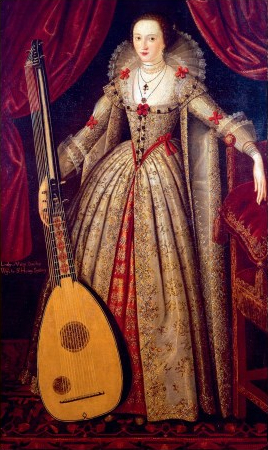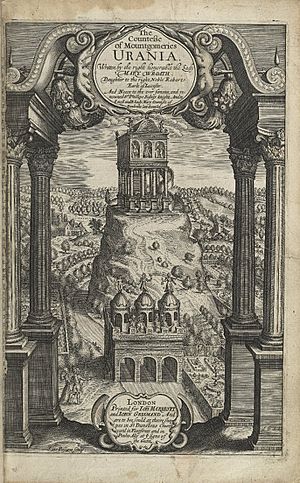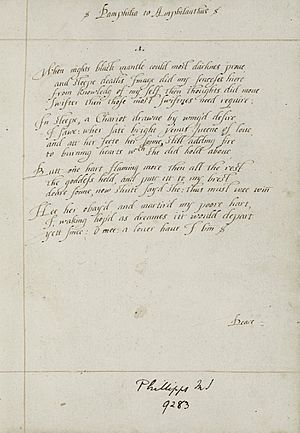Lady Mary Wroth facts for kids
Lady Mary Wroth (born Sidney; October 18, 1587 – around 1651-1653) was an English noblewoman and a poet during the English Renaissance. She came from a very famous family of writers. Lady Mary Wroth was one of the first English women writers to become well-known and remembered. She was the niece of Mary Herbert, who was also a famous writer and supporter of other writers. Her uncle was Sir Philip Sidney, a well-known poet and courtier from the time of Queen Elizabeth I.
Contents
Her Life and Times
Growing Up and Learning
Mary Wroth spent much of her childhood at Penshurst Place, a grand country house. Her father, Robert Sidney, was a governor. Penshurst Place was a hub for writers and artists back then. It was a place known for its warm welcome, even praised in a poem by Ben Jonson.
During this time, most girls did not learn to read or write. But Mary was lucky! She received a formal education from tutors at home, guided by her mother. Because of her family's important connections, it was expected that she would work at the royal court. Mary even danced for Queen Elizabeth I in 1602. Later, as a young woman, she became a close friend of Queen Anne and took part in court shows and plays.
Marriage and Challenges
In 1604, King James I arranged for Mary to marry Sir Robert Wroth. Their marriage was not a happy one. Sir Robert Wroth often gambled and drank too much. Ben Jonson, a poet and friend of Mary, even wrote that "my Lady Wroth is unworthily married on a Jealous husband." Mary also wrote to Queen Anne about her husband's money problems.
A Court Performer
Even with her difficult marriage, Mary became known for her writing and for performing in court plays called "masques." In 1605, she danced in The Masque of Blackness. This show was designed by Ben Jonson and Inigo Jones. Mary Wroth and Queen Anne, along with their friends, painted their skin black to play "Ethiopian nymphs." This masque was very popular. They also appeared in The Masque of Beauty in 1608.
Later Life and Family
In 1614, Mary had a son named James. Sadly, her husband Robert Wroth died just a month later, leaving Mary with many debts. Two years after that, her son James also passed away. This meant Mary lost her family estate.
After her husband's death, Mary started a relationship with her cousin, William Herbert, 3rd Earl of Pembroke. They had been friends since childhood and both loved art and literature. They had two children together, a daughter named Catherine and a son named William.
Her Famous Writings
The Countess of Montgomery’s Urania
In 1621, Mary Wroth published a book called The Countess of Montgomery’s Urania. This was the first long story written by an English woman that we still have today. The book was very popular but also caused a scandal. Many people thought it was a "roman à clef," meaning it told real-life stories about important people but changed their names.
The story is about a character named Pamphilia and her wandering lover, Amphilanthus. Many experts believe parts of the story are about Mary Wroth's own life. Even though Mary said she never meant to publish the book, powerful noblemen criticized her. They were upset because they felt she wrote about their private lives. Because of the scandal, Urania was taken off sale by December 1621.
Some writers did praise her work, like Ben Jonson. He said that by reading Mary Wroth's works, he became a better poet. However, another writer, Edward Denny, criticized her harshly.
Pamphilia to Amphilanthus
Mary Wroth also wrote a collection of poems called Pamphilia to Amphilanthus, published in 1621. This was the second known collection of sonnets (a type of poem) written by an English woman.
There was also a second part of Urania that was not published until 1999. This part was never fully prepared by Mary Wroth for publishing.
Later Years
After the problems with her book, Mary Wroth left King James's court. William Herbert also left her. Not much is known about Mary Wroth's last years, but she continued to struggle with money. She died sometime between 1651 and 1653. Today, a path near Loughton Hall is named Lady Mary's Path in her memory.
Her Main Works
- Love's Victory (around 1620) – A play meant to be read, not performed on stage.
- The Countess of Montgomery's Urania (1621) – The first long story by an English woman.
- Pamphilia to Amphilanthus (1621) – A collection of poems, mostly sonnets.
Images for kids







